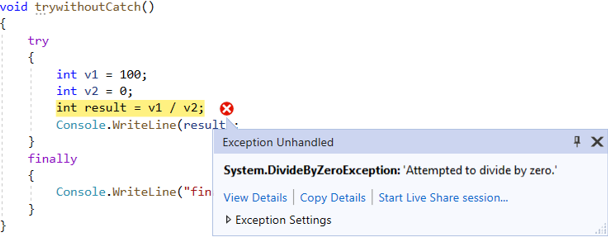C# - 'try' block without 'catch' block
Indeed, it's possible to use a try block without pairing it with a catch block. Often this approach is taken when executing code that may trigger an exception, yet there's no requirement to immediately address this exception within that segment of the code.
When you have a try block without a catch block, the following happens:
-
If an exception is thrown within the
try block, the program will not handle it at that point.
-
The exception will propagate up the call stack to the nearest enclosing
catch block (if available) or terminate the program if there is no higher-level exception handling.
This approach enables the management of exceptions at a more advanced level in your code, or in a different setting where you possess greater insight into addressing the particular exception.
Here's an example to illustrate having a try block without a catch block:
using System;
class Program
{
static void Main()
{
try
{
// Code that might raise an exception
int result = Divide(10, 0); // This will raise a DivideByZeroException
Console.WriteLine("Result: " + result); // This line won't be reached due to the exception
}
finally
{
// Cleanup code that always executes
Console.WriteLine("The finally block is executed regardless of exceptions.");
}
}
static int Divide(int a, int b)
{
return a / b;
}
}
In this example, the try block calls the 'Divide' method, attempting to divide 10 by 0, which raises a DivideByZeroException. Because there is no catch block to manage the exception, the program transfers the exception to the nearest available handler, which is not present in this particular instance. Consequently, the exception will end the program, yet the finally block will still run to make sure any necessary cleanup tasks are completed.
It is crucial to think carefully before choosing to use a 'try' block without a matching 'catch' block, as not handling exceptions might result in unforeseen actions or possible application failures. Generally, it is advisable to add suitable catch blocks to manage exceptions and act appropriately.
Example below is related to unhandled exceptions which will lead to abnormal termination of the program or application crachses:

- Purpose of `try` Block: Encapsulates code that might throw an exception, allowing the program to continue even if an error occurs.
- Absence of `catch` Block: Must be accompanied by a `finally` block or a `throws` clause in the method signature.
- `finally` Block: Executes code such as closing resources, regardless of whether an exception was thrown.
- Exception Propagation: Exceptions are not handled locally but propagate up to the nearest enclosing `catch` block or lead to termination if uncaught.
- Resource Management: Often used with resource management constructs like `try-with-resources` in Java.
- Cleaner Code: Can lead to cleaner code, especially when exceptions can be handled at a higher level.
- Responsibility for Exceptions: Delegates the responsibility for handling exceptions to the caller of the method.
- `throws` Clause: If a `try` block may result in a checked exception, the exception must be declared in the method signature.
- Use in Asynchronous Code: In asynchronous programming, `try` without `catch` might be used differently, such as in JavaScript promises.
- Best Practices: It’s good practice to only catch exceptions that you can handle; otherwise, let them propagate to a level that can handle them properly.